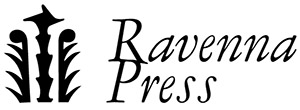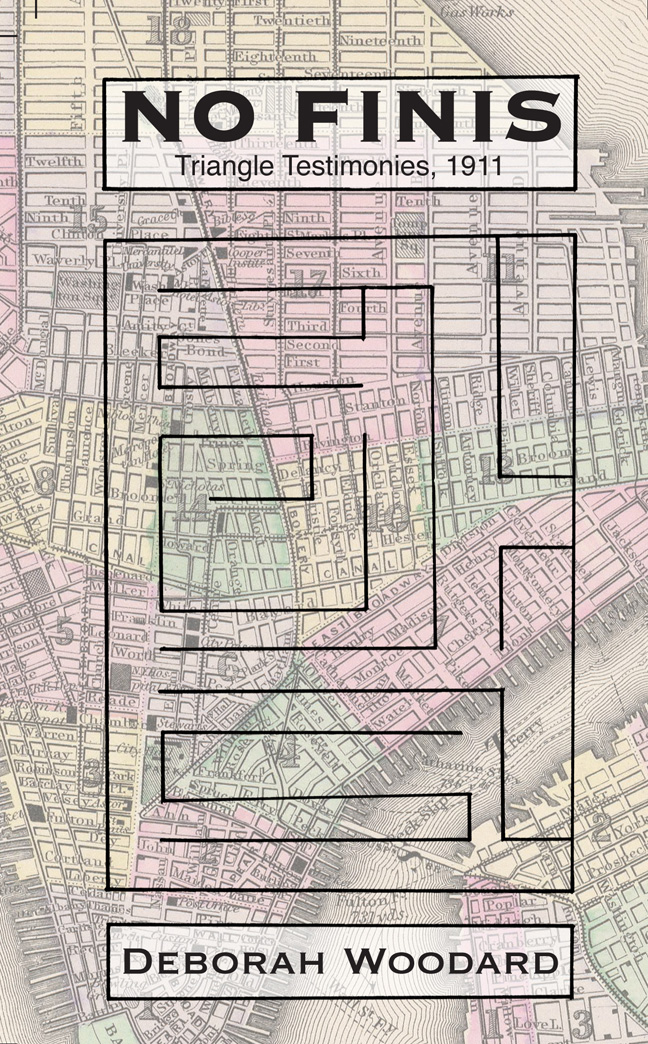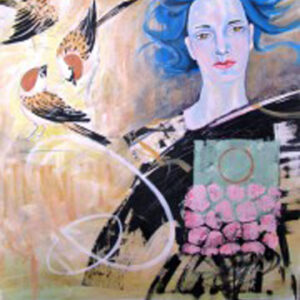No Finis; Triangle Testimonies, 1911
by Deborah Woodard
$16.00
Description
An elegant selection and poetic rendering of often harrowing trial testimony from survivors of the Triangle Fire in 1911, New York city, where workers died in the infamous fire at the shirtwaist factory. Well-accompanied by illustrations by John Burgess that enact their own examination.
In No Finis: Triangle Testimonies, 1911, Deborah Woodard creates a book for our moment by excavating and illuminating a famous yet half-forgotten moment of past judicial and economic injustice against immigrants. These mordant, stubbornly human prose poems are collaged from the transcripts of the trial of the owners of the Triangle Shirtwaist factory. Woodard has an unerring poet’s ear for the alive language of the witnesses, a vividly pungent, insistent language edited and censored by the courts yet straining to be heard. And her book erupts with the wayward realities of human feeling struck out or made invisible by the unfolding narrative of the apparatus of the court. In No Finis, immigrant survivors continue to be heard even as they continue to be questioned and squelched to this very day. Testimony, John Burgess’s drawings of the social spaces the workers inhabited, from work lofts to graves, complements and completes this act of bearing witness.
Sample:
I seen a doorway open. I didn’t know what it was, whether staircase or elevator. Suddenly he started away, and I just got in. The smoke came from the floor below, and I was rubbing against the walls. I said, “Please, girls, my feet!” There wasn’t room for a pin.
See the interview in Adroit Journal: https://theadroitjournal.org/2019/12/19/a-conversation-with-sheryl-st-germain-and-deborah-woodard/
Plus. see the review in the Literary Journal: http://www.theliteraryreview.
Comments/Reviews:
“NO FINIS is a startling body of work based on transcripts of the trial that took place in New York City in 1911, after hundred & forty six garment factory workers – mostly young women recently arrived from eastern Europe & Italy, died in a fire in their factory on the top three floors of the Asch building. The building was renamed Brown building, and has become a part of the New York University. Deborah Woodard started writing this book deeply moved by her visit in 2011 to New York University’s centenary exhibit ‘The Triangle Shirtwaist Factory Fire : Hundred Years After’. The tragedy had occurred on March 25, 1911. Deborah’s imagination was also sparked by her musings on the labour exchange her mother had engaged in – writing in exchange for sewing (she wrote for her friend’s children and received clothes in return). Deborah wondered: could those garment factory workers afford the shirtwaists they made ? This book is based on transcripts of the trial ‘The People of New York Vs Isaac Harris and Max Blanck’ and Deborah focuses on the cat & mouse game that the lawyer Mr. Steuer played with witnesses.
“Deborah Woodard’s newest chapbook, No Finis, is a striking reimagining of the infamous 1911 Triangle Shirtwaist Factory fire trial. Her poems reify the experiences of the victims and, in doing so, shed a timely light on issues of labor injustice, women’s rights, and immigration. Woodard imaginatively excises lines from the trial transcript and arranges them into poems, adding, as she writes in the forward, “a few fictional threads,” while maintaining the integrity of the original words.
Historically, the owners of the factory, Isaac Harris and Max Blanck, were ultimately acquitted of the deaths of the 146 garment workers, but the trial laid the groundwork for examining the conditions of similar factories in the United States. As the collection illustrates, the trial illuminated the cramped working conditions and poor escape routes; notoriously, one of the two exits was locked and opened inwards instead of outwards, preventing the crush of workers—mostly women—trying to escape from pushing the door down.
The collection focuses on the defense attorney Max Steuer’s dizzying cross-examination of the witnesses, which include survivors, firemen, and merchants to the factory. Interspersed throughout the collection are illustrations representing the claustrophobic work environment of the factory. The drawings, by artist John Burgess, not only stand in for the original diagrams the witnesses were asked to study, but also resonate with deeper meaning when paired with Woodard’s poems. Together, the poems and illustrations give the collection itself a kind of claustrophobia—especially with the repetitive titles of the poems, named only for the witnesses Steuer is examining. In this way, the chapbook, ingeniously, might be seen as giving the reader the same experience as the victims of the fire and the witnesses in the trial: a sense of being trapped, moving through lines that, mazelike, never give us a full picture of what exactly happened. And yet, Woodard’s talent is in still giving us the full depiction of the tragedy, of evoking its harrowing depth. The ending lines of the poems are exemplary, as in “Jacob Woll, Fireman, Recalled to the Stand,” which focuses on the burned door and a single piece of hardware the fireman recalls, a hinge on the wall. The final line of the poem reads, “the wishbone is a hinge,” an image that viscerally places us in the minds of the victims, trapped by a mere hinge. Another poem, “Mr. Steuer and James Whiskerman” ends, “neglect is both more random and more cumulative than order,” a line that speaks hauntingly to the unjust conditions of the garment workers.
Throughout, the collection also plays with the idea of materiality, of what it means for something or someone to have significance or meaning. Woodard’s selections lay stress on the literal material of the factory—fabric and rags—which then adds deeper meaning to some of the language speakers employ. In one poem, for example, a witness describes the fire as “seamless,” a particularly apropos image of a fire in a garment factory. When Steuer or the Court object to a claim as “immaterial” we pause a little longer to reflect on that word’s layers of meaning. In “Mr. Steuer and Sam Bernstein,” when the witness is asked if he was injured in the fire, he simply replies, “My hat and my overcoat I left behind.” While the Court interjects to say the witness (an immigrant who speaks mainly Yiddish) didn’t understand the question, the mistake is indicative, and speaks to Woodard’s stated interest in the trial: the relationship these workers have to their own trade. These workers survive by making clothes they cannot even afford; the man was materially—monetarily, significantly—injured by the loss of his clothes.
In this way, Woodard’s collection speaks to the injustices these workers—mostly immigrants, mostly women—endured. The rapid back and forth of the cross-examination often hints at Steuer’s derogatory treatment of the witnesses. In “Mr. Steuer and Ethel Monick,” for example, he says to the witness, “We are waiting, little girl.” Later, when Steuer asks if she was afraid of the factory owners, she replies, “Not exactly afraid. You know they are—I was nothing to them, you know, because I was only a working girl.” Her answer resonates with us because we know the outcome of the trial—she and all the other workers, the 146 victims of the fire, were judged as nothing, and the owners went free. Powerfully, then, Woodard’s poems offer the men and women of the factory a voice, and thus materiality. As the title of the collection suggests, their stories should not end with the fire.
In reading this collection, I found that a moderate understanding of the Triangle Shirtwaist Factory fire was helpful, perhaps integral, to grappling with these poems. But while Woodard’s collection revolves around a trial from over a century ago, the issues its lines lay bare are both timely and timeless, namely, justice for the oppressed and victimized. As might be assumed for poems that draw from a primary text, the language is unaffected, but Woodard’s arrangements are profound. This is an original collection with abiding concerns.” (Alexa T. Dodd, Heavy Feather Review)
“For whatever reason, one of the few things I retained from high school history class was the story of the Triangle Shirtwaist Factory fire of 1911. Nearly 150 people died, and the event helped usher in better building codes and working conditions in America. The event has stuck around in my head for 20+ years, the memory of all those women in a hot, crowded factory, a crummy job leading to a cruel end.
When I heard about Deborah Woodard’s No Finis: Triangle Testimonies, 1911, I got excited. Poets who form collections around historical events (Teow Lim Goh, Mariko Nagai) always fascinate me. They seem to haunt these events they write about, the poems circling, circling, like ghosts moving around a place or icon that hasn’t lost its hold on a soul. I write essays like that, but I’m incapable of poetry. I wish I could insert “haunted collection” ideas into poets’ heads: write about Chernobyl, Carl Phillips. Write about Atlantis, Carolyn Forché. And here is a collection about one of those flukey historical events, one I remembered and very much wanted to read poetry about.
The poems in No Finis are collages, narrative snippets cut and pasted to make century-old voices ring out plainly. Woodard delves into the transcript of a trial that resulted from the fire (the two men who owned the factory were charged with just one of the 146 deaths), and she plucks out testimony to rearrange and present. Each poem is a portion of this testimony. From “Mr. Steuer and Rose Mayers,” for example:
A door that was locked with keys, you went to open with your hands?
Not only me, about fifty of us.
You cannot tell us any girls that tore at the door, can you?
One girl by the name of Jennie. She used to give out the laces.
The nature of reading changes depending on how a text is presented, of course. Presented as a poem, this trial testimony gains enormous gravitas; every word drops on the reader like a small stone. “She used to give out the laces” is ordinary in one light, slipping by as a practical description, and yet it has a rhythm and a meaning that appeals to the ear and the heart more than most lines of trial testimony do. “The laces,” objects that have significance to Rose but not to the reader, or potentially to the examining attorney, Mr. Steuer. “Used to,” meaning that does not happen anymore, either because Jennie is dead, or because Rose no longer works at the factory, or both.
The language sometimes veers into the strange. “I see the fleck of a supposition, like the sweet taste of an old apple,” Mr. Steuer muses in “Anna Gullo, Recalled to the Stand.” “The tree uncooped its birds!” he exclaims in “Mr. Steuer and Katie Weiner.” “I dream two scars where the wings should be. I see the mechanical up and down of the feathers each time I breathe,” Ida Okan testifies, in “Mr. Steuer and Ida Okan.”
Isn’t it a fact that you were excited and didn’t know what you were doing?
I had in mind my sisters and couldn’t look at the things around me.
Did you cry out for your sisters, then?
Yes, the younger one. The older one was sitting far away.
In her Foreword, Woodard writes a short history of the fire and then offers a little information about her method: “I compressed representative cross-examinations and added in a few fictional threads that seemed indicative of the state of mind of the witnesses, and sometimes of Steuer, as well. The source material…contributed its own oddities.” I cannot tell from this statement whether the weird turns of phrase that sometimes occur in No Finis are part of the original testimony or part of Woodard’s craft, or if it varies. Such uncertainty is likely great and good for poets, but for readers like me it is torture. Tell me what’s what. I must know.
The book also bears a series of ten images by John Burgess, “Testimony,” each a hand-drawn diagram of some element of the Triangle fire. These drawings are explained in the back of the book. I remain unsure about their contribution to No Finis; they are not visually arresting, nor are they obvious or symbolic, for the most part. Only one, depicting 146 hand-drawn, numbered rectangles, felt distinctly impactful. The rest required their captions.
Each poem bears a final line, following a break, that is the least sensible, most poetic part of the poem. They feel like snippets of thoughts, rather than testimony: “mechanically she gripped the air’s one rung,” “the wishbone is a hinge,” “alone, there were many people there, but I came alone.” I wanted to assemble all these lines into a single poem, to collage this collection of collages. They spoke to me so much more than the rest of the poems, which fell strangely flat. I don’t think every reader will feel this way — it’s a subjective review — but I wanted something else than what this collection happens to be. Something which seizes this one horrific day 108 years ago and from it, drew big, unpredictable lines of flight in the sky.
Woodard has created a restrained, ultimately unknowable collection from existing materials, and that is a work of craft I admire, and can recommend.” (Katharine Coldiron, in ”Anomaly”, the Features Supplement to the Online Journal of Literature and Art)








Reviews
There are no reviews yet.